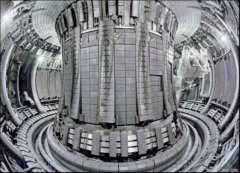The Joint European Torus - World
First Magnetic Confinement Fusion
The Joint European Torus (JET) has demonstrated workable fusion in a magnetic confinement environment. Situated on the site of the Culham Centre For Fusion Energy Research (CCFE) south of Oxford in England it acts as a centre for European fusion research at least as far as magnetic confinement of plasma is concerned.
In 1960 the CCFE began as the UKAEA Culham (United Kingdom Atomic Energy Authority Culham) on an 80 hectare site of a previous naval airfield.

Images Courtesy of Joint European Torus Website
The United Kingdom research is now focused on another project - MAST (Mega Amp Spherical Tokamak) - which is funded by both the UK and the European Union as another magnetic confinement approach.
The Joint European Torus operates next to the MAST project under a European umbrella, the European Fusion Development Agreement (EFDA) as the EFDA-JET Close Support Unit.
Structure
About 500 people work on the JET site with visiting scientists arriving from throughout Europe.
Originally in its early history JET was managed by EURATOM composed of member nations Austria, Belgium, Bulgaria, Czech Republic, Denmark, Estonia, Finland, France, Germany, Greece, Hungary, Ireland, Italy, Latvia, Lithuania, Malta, The Netherlands, Poland, Portugal, Romania, Spain, Slovakia, Slovenia, Sweden, Switzerland, United Kingdom.

Initially there was a differential pay scale for United Kingdom and non-United Kingdom workers - the latter receiving about twice the salary of the British workers. This was contested and eventually over-turned to allow pay parity. At this point EURATOM was replaced by the current EFDA-JET Close Support Unit.
The purpose of the European Fusion Development Agreement is to provide a framework for magnetic confinement controlled thermonuclear fusion research and development within the European Union and Switzerland.
After discussion in 1970 a decision was made to undertake a European Union fusion programme. Design work on JET began three years later. Construction began in 1977 the same year Culham was chosen as the site for JET.
Beginning operation in 1983, the Joint European Torus produced its first short-lasting plasma.There were many challenges to establishing a confined, controlled plasma. Repeated adjustments needed to be made to achieve this.

A First - Controlled Fusion
The first controlled (as opposed to weapons produced) deuterium-tritium fusion reaction was achieved in 1991.
In 1993 the TFTR Princeton Tokamak used equal parts of deuterium and tritium, then in November 1994 achieved 10.7 megawatts of fusion.
The Joint European Torus achieved a world record on 16 megawatts of fusion power in 1997 from a 25 megawatt input - still a lesser output compared to input power.
Tokamak Build
JET is currently the largest tokamak in the world. Also it is currently the only one able to use the proposed deuterium and tritium hydrogen isotope mix proposed for ITER.
Heating of the plasma occurs in three ways - by radiofrequency through ion cyclotron resonance, lower hybrid current drive, and by injecting a neutral beam (nuclei combined with their electrons to allow penetration though the magnetic confinement field) of hydrogen.

Achieving fusion in this apparatus requires the generation of temperatures of around 150 million degrees - ten times hotter than that of the sun - due to the low pressure compared to that in the sun.
Confining the plasma is by means of currents run through coils that create strong magnetic fields. The currents will heat the coils which need to be cooled through water cooling systems in JET's case. ITER will use liquid helium to supercool its wires to improve current efficiencies. The coils are the highest cost elements of a magnetic confinement unit.
Power consumption to run JET is high - around 500 megawatts - half required for the toroidal field coils, around 100 megawatts for the poloidal fields arranged horizontally and vertically and adjusted to control the variations in the plasma shape and confinement. The extra power provides the heating of the plasma.

To deal with edge changes in the plasma a diverter configuration was put in place in 1993. The waste products of alpha particles need to be removed from the system to maintain plasma heating. Helium is effectively the ash of the process. As they track from the central part of the plasma the material cools allowing contact with the tokamak walls to occur with lessened risk.

A remote cleaning and handling system was developed in 1998. This ability is crucial with radioactive tritium being used as the fuel.
Joint European Torus And ITER
Much of the work ongoing these days is in testing designs and materials that will be incorporated in the ITER project in France.
Another organisational structure, Fusion for Energy (F4E), has been put in place as the European Union's response to participating in the ITER initiative.
The Joint European Torus has signed an agreement to connect development and research with ITER - testing ideas and supplying results to speed the Cadarache, France development.
They aim to test an ITER-like internal wall of beryllium, neutral beam enhancement to boost heating of the central plasma, and a high frequency pellet injector to constantly resupply fuel.
They also want to study alpha particle (helium nuclei) handling as this will be a product of the ITER - the "ash" as noted above. If it is not actively removed and instead kept in the active plasma it will dilute and interfere with it.
In 2006 the Joint European Torus was coverted to ITER-like magnetic configurations. Between October 2009 to May 2011 an ITER-like wall was installed.
New! Comments
Have your say about what you just read! Leave me a comment in the box below.